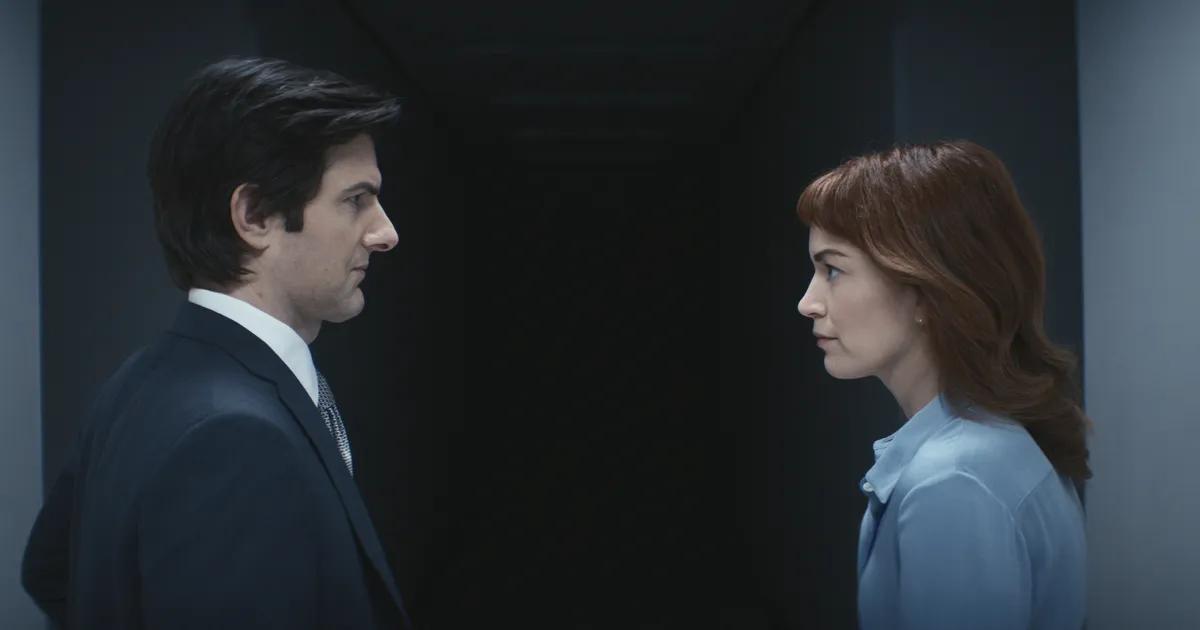Apple TV+’s Severance became one of the most talked-about series for its unique blend of psychological mystery, dystopian satire, and emotional storytelling. Created by Dan Erickson and directed mainly by Ben Stiller, the show explores the extremes of work-life balance through the fictional Lumon Industries, a company that surgically divides employees’ consciousness into “innies” and “outies.”
This separation creates two distinct identities: one who exists only at work and another who lives outside of it. Season 1 concluded with shocking revelations, emotional cliffhangers, and intriguing hints of a larger conspiracy that left viewers eager for Season 2.
At the core of Severance is Lumon Industries’ “severance” technology, which physically divides a person’s memories between work and home. For the outies, this procedure promises perfect work-life balance with no stress from the office after hours. For the innies, however, it is a nightmare, as they live only within the confines of the workplace. Throughout the first season, Lumon’s sterile hallways, cryptic rituals, and secretive management create an unsettling environment that reflects corporate obsession with control and productivity.
The finale introduces the Overtime Protocol, activated by Dylan, which allows three innies to experience the outside world for the first time. This single event sets off chaos as Mark, Helly, and Irving uncover disturbing truths about their real lives, turning Lumon’s experiment into a potential rebellion against their employers.

Revelations of Love, Identity, and Power Reshape Mark and Hellys Journeys Within Lumon
One of the most emotional revelations in Severance Season 1 is the discovery that Mark’s presumed-dead wife, Gemma, is alive and working at Lumon as Ms. Casey, the wellness counselor. Mark joined Lumon to escape the grief of her death, yet the company secretly used her as part of its severed employee program. This twist reshapes Mark’s entire emotional journey and raises disturbing ethical questions about Lumon’s power over identity and humanity.
The season ends with Mark’s innie shouting “She’s alive!” to his sister Devon while holding Gemma’s photograph, just before the system shuts down. This moment suggests that Mark’s outie may soon learn the truth, potentially sparking Lumon’s downfall. The company’s manipulation of both Mark and Gemma shows that its reach extends beyond the workplace and into the most intimate parts of its employees’ lives.
Helly’s struggles throughout Season 1, including multiple escape attempts and a suicide attempt, gain new meaning when her true identity is revealed. She is actually Helena Eagan, the daughter of Lumon’s CEO, Jame Eagan. Her severance procedure was designed as a public relations stunt to prove that the process is safe and ethical. However, her innie’s rebellion during the Lumon gala, where she exposes the torment of the innies to the audience, turns the company’s propaganda into a scandal.
Helly’s dual identity highlights the hypocrisy of Lumon’s leadership. Her outie, a privileged heiress, endorses a system that dehumanizes others, while her innie becomes its strongest critic. This contrast between privilege and suffering embodies the show’s central message about moral blindness and the cost of corporate success built on the exploitation of others.
Love, Loyalty, and Control Define Emotional Bonds and Moral Conflicts Within Lumons Oppressive Walls
The relationship between Irving, played by John Turturro, and Burt, played by Christopher Walken, brings emotional warmth to Lumon’s cold and impersonal environment. Their connection inside the company shows that even within a system built on control, genuine human emotion can survive. In the finale, Irving’s innie awakens outside and searches for Burt, only to find him living with another partner. Irving’s desperate knocking on Burt’s door is interrupted when the Overtime Protocol ends, leaving their fate unresolved.
Clues found in Irving’s home, including paintings of Lumon’s elevators and files on severed employees, reveal that his outie might already be investigating the company. This suggests that both versions of Irving are fighting against Lumon in different ways, making his story one of quiet resistance and emotional depth.
Harmony Cobel, portrayed by Patricia Arquette, stands out as one of the show’s most complex figures. Known inside Lumon as an authoritarian manager and outside as Mrs. Selvig, Mark’s seemingly kind neighbor, she moves between two identities with mysterious intent. After being fired by Lumon for hiding Helly’s suicide attempt, her loyalty becomes uncertain. Her desperate attempt to stop the Overtime Protocol may signal devotion to Lumon or fear for the workers’ safety.
Cobel’s fascination with Mark and Gemma’s relationship hints that she knows more about Lumon’s experiments than she reveals. Her actions suggest an internal conflict between faith in the company and a growing awareness of its moral decay. Whether she becomes an ally or remains an enemy in Season 2 remains to be seen.
Milchick, the ever-smiling supervisor of the severed workers, represents the enforcement arm of Lumon’s control. His cheerful demeanor masks a frightening devotion to the company’s order. In the wake of Dylan’s rebellion, Milchick is expected to lead the punishment of the Macrodata Refinement team. Lumon has numerous unexplained protocols, such as Clean Slate, Lullaby, and Branch Transfer, hinting at ways to erase or reprogram employees.
Season 2 will likely explore how far Lumon will go to maintain secrecy and obedience. Milchick’s actions reveal the cruelty behind corporate discipline, showing that in Lumon’s world, even memory is a tool of punishment and control.

Unanswered Mysteries, Creative Choices, and Critical Praise Shape Severance’s Lasting Emotional Impact
The finale confirmed several major fan theories, such as Helly’s identity as Helena Eagan and Gemma’s survival. However, it left other mysteries unresolved, including the true purpose of the cryptic numbers the innies process and the connection between Lumon and the military. Artifacts in Irving’s home suggest that the severance procedure may have originated as an experiment on soldiers dealing with trauma.
The subplot involving Gabby Arteta also expands the world beyond Lumon’s walls. As the wife of a powerful senator, she admits to being severed during childbirth, hinting that the technology has already spread into society. This revelation broadens the show’s commentary on how power and privilege shape the boundaries of ethics and consent.
Showrunner Dan Erickson and director Ben Stiller have discussed the creative process behind the finale’s cliffhanger. Stiller proposed ending the season exactly as the Overtime Protocol shuts down, leaving the audience suspended in the same uncertainty as the characters. Erickson agreed that this moment offered the strongest emotional and narrative impact, even if it would leave viewers impatient for more.
Adam Scott, who plays Mark, described filming the finale as both exhilarating and exhausting. He explained that discovering the truth about Gemma while filming the climactic “She’s alive!” scene was one of the most emotional experiences of his career. The creative team wanted the episode to feel like both a revelation and a promise of greater mysteries to come.
The finale of Severance Season 1 received widespread critical acclaim. Reviewers praised its balance of closure and suspense, calling it one of the strongest season endings in recent years. The A.V. Club described it as a “pitch-perfect finale” filled with emotional intensity, while Forbes named it one of the best episodes of television in recent memory. Fans echoed these sentiments online, describing it as a tense, satisfying, and unforgettable viewing experience.
Unlike many mystery-driven shows that lose focus, Severance maintained its depth and coherence through careful pacing and character development. Its mix of surreal humor, psychological horror, and emotional realism elevated it beyond simple science fiction, solidifying its reputation as a standout in contemporary television.
Beneath its futuristic premise, Severance is a reflection on power and identity in the modern workplace. Lumon’s manipulation of its employees mirrors the ways corporations demand loyalty, suppress individuality, and blur the boundaries between personal and professional life. The innies’ rebellion becomes a metaphor for the human desire for autonomy and dignity in systems that seek to suppress both.
The final revelations show that Lumon’s control extends beyond its offices into the personal lives of its workers. The company’s influence over Mark’s memories and Gemma’s existence demonstrates a chilling level of domination. Yet, even within this oppressive structure, the characters’ compassion, love, and defiance prove that humanity can endure. Season 2 promises to build on these themes, transforming Severance from a workplace thriller into a profound exploration of freedom and selfhood.



